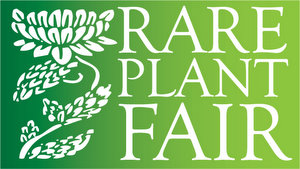Hard-working Plants for Late Summer and Autumn Colour
Billy Stott, from Stotts Nursery in Buckinghamshire, with his choice of shrubs, trees and perennials that offer colour later in the season, either through flower or foliage. - 22 August 2025
Late summer can often be a time when gardeners are looking for a bit more colour, as the mainstays of the summer borders start to fade and many plants put energy into setting seed. There are lots of options to increase your display of flower and leaf colour, here are a few which are easy to grow and give interest over a long period.
Euonymus maackii (Formerly E. bungeanus)- A small tree with soft green leaves which hang gracefully, turning a fantastic cream and pink colour in late summer and autumn. Pink seed pods bearing bright orange fruits are produced from late summer and stay on the plant after the leaves have dropped on our mother plant. It should thrive in any well-drained soil and ours even grows well on solid, non-waterlogging clay. Hardy down to -30oC! From the China, Japan, South Korea area.

Heptacodium miconioides (Seven Sons Tree)- This large shrub/ small tree has peeling, shaggy bark and dark green leaves which curve inwards and fold back on themselves, looking a bit like a crescent moon. Clusters of small white, highly scented flowers are produced from late August onwards for us. Once the petals drop, the calyx develops from green to deep pink, so it carries on giving interest well after the blooms are over. Grows well on any well-drained soil and tolerates shade well. Originally from China.
![]()
Hydrangea serrata ‘Chiba Cherry Lips’- Beautiful bronzed leaves emerge in spring, getting darker in full sun. White lacecap type flowerheads with outer florets being edged with cherry red are produced in August and the leaves change to fantastic reds, pinks and creams in autumn, sometimes lasting into November. It should thrive in any reasonably fertile well-drained soil, great for clay. Introduced from China by Sue and Bleddyn Wynn-Jones of Crûg Farm Plants.


Deutzia gracilis ‘Nikko’- A compact Deutzia (60-80cm tall) with narrow dark green leaves. Arching racemes of lightly fragrant white flowers are produced in spring and early summer and give a wonderfully soft look. The autumn leaf colour can be outstanding; last autumn we had red, burgundy, orange, yellow and purple can all be seen on the same plant, as the pictures show. Native to Japan, it grows well in most soils and tolerates light shade.

Fuchsia ‘Dying Embers’- a dark, moody beauty of a Fuchsia which has dark red/purple stems and dark green leaves with purple veins. Very deep aubergine, almost black corollas (inner part of the flower) are capped by crimson coloured sepals and it flowers for a long period through summer and auutmn. In very cold winters the upper branches may die back, but new shoots should emerge from the base, as many Fuchsias do. Plant in partial shade, in any soil that doesn’t waterlog in winter and doesn’t dry out completely in summer.

Rudbeckia subtomentosa ‘Henry Eilers’- a great upright Rudbeckia which has curious spoon-shaped yellow petals which are tinged red on the undersides. It will tolerate drier soils and flowers from late August onwards. Grows to around 1.2m tall; this year it is shorter due to the dry weather, but is still looking good. Performs best in full sun, in any well-drained soil. Found in Illinois by Henry Eilers and eventually named after him.

Althaea cannabina (Palm-leaved Marsh Mallow)- A lovely willowy, tall herbaceous perennial which is great for the back of borders and with grasses, as it dances on the wind. Clusters of pink, cup-shaped flowers which sometimes have a darker pink ‘eye’ are produced on tall stems from midsummer to autumn. From the Mediterranean originally, it loves a well-drained, sunny spot.

Symphyotrichum ericoides var. prostratum ‘Snow Flurry’ (Formerly Aster)- there aren’t too many herbaceous perennials which have pure white flowers in autumn, but this smashing little prostrate aster does. At 10-15cm tall, it is great for edges of borders or for cascading over the edges of raised beds and walls and is covered in tiny, pure white flowers throughout autumn. Brought to the UK by Beth Chatto after an eastern USA lecture tour. It likes a sunny position, in any well-drained soil and is tolerant of drier conditions.

Eutrochium maculatum ‘Purple Bush’ (Formerly Eupatorium)- This herbaceous perennial is loved by all sorts of pollinators and because it is shorter than many other eupatoriums, you can actually see them and the flowers! Standing at around 1.5m tall, the strongly upright stems are topped with clusters of dusky pink flowers from August to October and the seedheads dry nicely for winter interest. Plant in full sun or partial shade, ideally in a moist soil. However ours has done well this year on our unwatered clay, even if it is a bit shorter.

Of course the weather impacts all of these timings and some years are better for autumn leaf colour than others, but hopefully there is something above to interest you.
Billy Stott owns Stotts Nursery, a small, family-run plant nursery nestled in woodland on the edge of the Chiltern Hills in Buckinghamshire. They mainly specialise in hardy plants which will cope with their hilltop conditions and have a wide range of herbaceous perennials, grasses, shrubs, climbers, trees and hardy annuals.
Website: https://stottsnursery.co.uk/
Fairs
Past Fairs:

 Handy Plants for Climate Change - Read More..
Handy Plants for Climate Change - Read More..
 Hard-working Plants for Late Summer and Autumn Colour - Read More..
Hard-working Plants for Late Summer and Autumn Colour - Read More..
 Perennial: Supporting people in horticulture across the UK - Read More..
Perennial: Supporting people in horticulture across the UK - Read More..
 2026 Rare Plant Fair Dates - Read More..
2026 Rare Plant Fair Dates - Read More..
 The Manor House Garden, Bledlow - Read More..
The Manor House Garden, Bledlow - Read More..